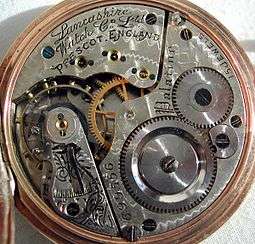Lancashire Watch Company

The Lancashire Watch Company of Prescot was founded in 1889 by Thomas P. Hewitt as a rival to the large American and Swiss watch companies. It failed in 1910.
History
Until the late 19th century, Prescot had been the centre of the watchmaking trade in England. The workers produced watch parts in small workshops attached to their cottages and were paid by piece work. By 1889 the American System of Watch Manufacturing meant that the Waltham Watch Company and others could produce watches at a much lower price and the town fell into decline.
In 1889 a company was formed and eventually a large factory was built to create complete watches under a single roof.[1] The products produced had more in common with earlier American designs than traditional English fusee watches. Because of economies of scale the Lancashire Watch Company struggled to compete with the larger American and Swiss factories. It could not make a profit and went bankrupt in 1910.
Thomas P Hewitt's personal watch was sold at Christies Auction in 1995 fetching $215,000, purchased by Robbie Dickson a well known historical watch collector
A comprehensive history of the company is now available in a new book published in May 2016, Lancashire Watch Company History and Watches, see below in Sources. The History Section describes how the company came about, how it went into decline and finally closure. The history of the company and its positioning within its home town of Prescot is told as it was written in newspapers, magazines, and journals of the time; primarily the local press and the Horological Journal. There is little comment from the author. The reason for this approach is a desire by the author not to propagate myths and incorrect information on the Lancashire Watch Company; and also not to pass judgement on the company or its players - readers can decide for themselves. This approach required many hours of painstaking reading, photographing and transcribing of articles most of which are not available electronically today. There is a Section which describes the company’s Ledgers. These were used to record the watches the company produced. The different type of watches are tabled together with an indication of the numbers produced of these types. The Watches Section comprises photographs of over 100 watches, split into several chapters showing different aspects of what the company produced. Almost all photographs within the book are in full colour. The final section, the Appendices, show known catalogues which have survived. These are shown in full. There is also a collection of photographs from the day and a useful list of all the watches which are photographed within the book. The book is not a technical book explaining the way pocket watches work. It will be of interest to anyone with an interest in pocket watches, and the development of watchmaking. The reader will also get some understanding of the socio-economic climate of the time, and life within Prescot. The book will be used by museums and libraries and will be an important addition to any private horological collection. (Note the book is a 'large' book. It has 528 pages and measures 33 x 24 x 3.5 centimetres.)
References
- ↑ "Reviving a Lancashire Industry". Manchester Times. British Newspaper Archive. 18 January 1890. Retrieved 27 June 2014. (Subscription required (help)).
Sources
- The Lancashire Watch Company: Prescot, Lancashire, England 1889-1910., Roberts, Kenneth D., Alan Smith, Henry G. Abbett, Ken Roberts Publishing, New Hampshire 1973 ISBN 0-913602-08-6
- Lancashire Watch Company History and Watches by John G Platt. Published by inbeat publications, Chester, UK; printed by Cambrian Printers, Aberystwyth, Wales; May 2016 ISBN 978-0-9573733-2-7